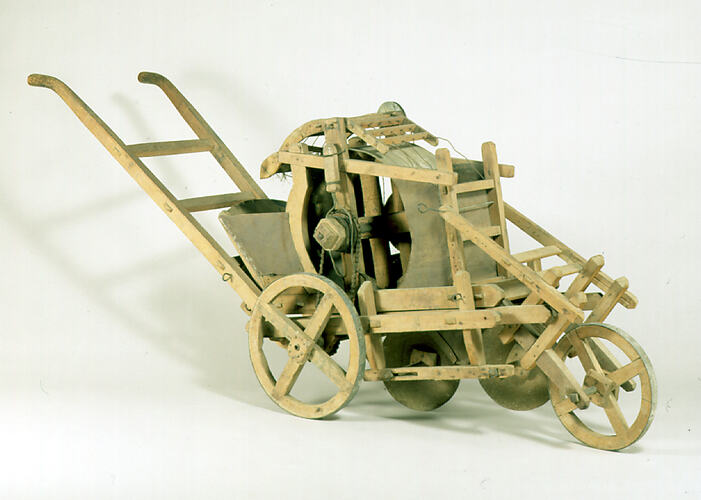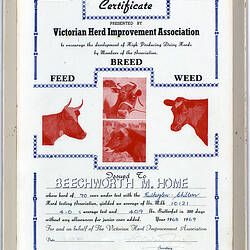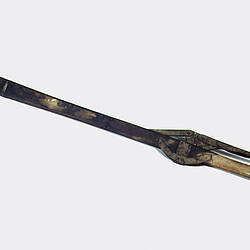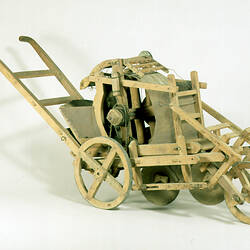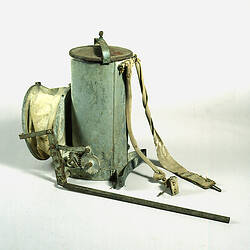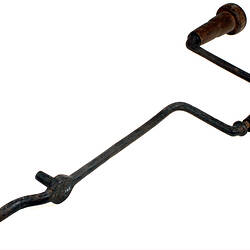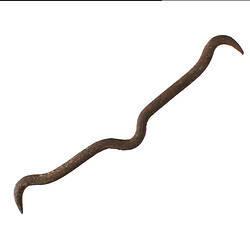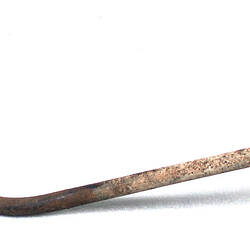Summary
An account of the farms and gardens on the grounds of psychiatric hospitals in Victoria Australia from 1881 to 1937.
Farms and gardens in Victorian mental health institutions In January 1881, the Leader newspaper published a lengthy description of the landscaping of the Kew Asylum grounds. Under the supervision of Mr Morrison, the farm bailiff and landscape gardener, the two recreation grounds provided for the patients had each been laid out with 'a large arbor [sic], walks, turf, flower-borders, shrubs, and shade-trees'. The enclosed airing courts were 'crossed by diagonal walks, and the ground planted with a choice assortment of shrubs, amounting to 200 different sorts'. Morrison had also overseen extensive planting of the terraced grounds around the building with a great variety of trees and shrubs.
He was also responsible for the management of the asylum farm, for which the Leader considered he showed ability equal to that demonstrated in the gardens, 'his crops and livestock being in capital condition'. The fifty dairy cows in the Asylum herd produced four hundred quarts of milk each day and butter much in excess of the institution's requirements. The piggery contained 'nearly two hundred pigs of the Berkshire breed' while twenty dozen eggs a week were gathered from the poultry flocks. From seventy-five acres of cultivated land were harvested 'mangles.maize, barley and tares, turnips and cabbages for the cows; hay...carrots and peas for the horses; barley, peas and wheat for the fowls and potatoes for the human beings'. The institution's male patients provided much of the labour for the farm, also assisting Morrison in the nursery where, according to the article, they 'had given the remains of their wits heartily and successfully' to the propagation of shrubs and herbaceous plants for the gardens (Leader, 1881, 9).
While there was certainly an economic motive in establishing asylum farms like that at Kew, in contributing to institutional self-sufficiency, they also reflected contemporary beliefs about the therapeutic effect of interacting with nature, whether through contemplation of the landscape, participating in outdoor recreations or engaging in horticultural or agricultural occupations (Philo 1987, p.407; Philo 2004, pp.576, 592-7; Hickman, 2009). This idea was certainly influential in Victoria. Three years after the Leader published its article, several witnesses appearing before a royal commission investigating the management of the asylums questioned the profitability of the farms, arguing that it would be more economic to buy produce (Report of the Royal Commission on Asylums for the Insane and Inebriate, 1886, Minutes of Evidence, Q.2079-82, pp.97-8; Q.2462-74, p.115; Q.9086-92, p.372; Q.11495-11549, p.500). When quizzed by the commissioners on the question, the medical officers were adamant that whether profitable or not, the farms and gardens played an important role in therapy (Report of the Royal Commission on Asylums for the Insane and Inebriate, 1886, Minutes of Evidence, Q. 8743-4, p.352; see also Q.9087-90, p.372, 11778-80 and Q.12163, p.522).
Dr Richard Youl, Chairman of the Metropolitan Board of Visitors, explained that finding 'occupation' for patients was 'the most curative thing you can do', adding that farming and gardening were occupations 'every man likes. People like to be out pottering about flowers, and it is a very good thing for them, and takes off their attention from themselves'. Farming and gardening, he concluded, even if they did not pay, were 'quite as cheap as drugs, and much more beneficial' (Report of the Royal Commission on Asylums for the Insane and Inebriate, 1886, Minutes of Evidence, Q.9185-98, p.380). Dr Patrick Smith similarly declared that engaging patients in farm work was 'one of the greatest means of cure' (Report of the Royal Commission on Asylums for the Insane and Inebriate, 1886, Minutes of Evidence, Q.12401-2, p.532).
By the early twentieth century, however, the emphasis had swung toward the more 'scientific' management of the farms and produce gardens (Report of the IGI 1912, p.32). In 1905 the newly appointed Inspector-General of the Insane, Dr W. Ernest Jones, requested permission to obtain the 'advice and help' of the Department of Agriculture in the operation of the asylum farms (PROV, VPRS 3994/P, Unit 47, Entry W6567). While the two officers assigned found the current operation of the farms satisfactory, they also recommended 'many ways in which still greater use should be made of the land allotted to each hospital'. Underlying their specific recommendations was the intention 'that, with the exception of bread and butter, practically the whole of the food stuffs required, and on an improved dietary scale, may be raised on the farms' (Report of the Inspector-General of the Insane 1906, p.23).
Annual reports in the decade that followed seem to reflect this new emphasis on efficiency, reporting more extensively than earlier on the success or otherwise of the farming endeavours at the various hospitals. In the report for 1908, for example, the Kew Hospital for the Insane reported both 'a probably record harvest' and the deficiencies of the kitchen garden, which in the in the view of the Superintendent was 'by no means the success it might be'. At Ararat 'the area under cultivation, and the harvest obtained, were double those of previous years - the hay crop yielding 150 tons'. Despite this improvement, the Superintendent considered that much remained 'to be done before the farming operations can be reasonably commended'.
Meanwhile, at Beechworth, both the farm and garden had proven profitable, with good crops from the farm and a 'plenty of vegetables of varied nature' from the garden. 'All the jam used was made on the premises from fruit grown at the institution, and the method of storing in earthenware jars, instead of open tins, is a long felt want supplied'. Male patients continued to provide the labour for these endeavours. In 1908, 212 men worked on the farm and 126 in the garden (Report of the Inspector-General of the Insane, 1908, pp.20-1, 23, 25).
In the same year as he sought the advice of the Department of Agriculture, the Inspector recommended the appointment of 'ornamental gardeners' so that 'the asylum grounds may be made more attractive' (Jones, 1905). Nothing came of this recommendation and six years later, with the opening of a new hospital at Mont Park looming, he again sought approval to appoint an ornamental gardener, to oversee the landscaping and planting there and to 'advise with regard to the other institutions'. Hugh Linaker, Curator of Parks and Gardens in Ararat, won the post from a field of forty-two applicants (PROV, VPRS 3992/P, Unit 1248, File 1912/M3591). Linaker, who worked for the Lunacy Department until 1937, 'regularly received praise from his superiors and initiated new landscaping or enhanced existing work at each of the hospitals under his control' (Aitken, 2002, p.371). In 1919, for example, the Superintendent at the Beechworth Hospital reported that, 'Steady progress has been made with the ornamentation of the grounds and the plans of Mr H Linaker.are beginning to mature. Both inside and outside the building the gardens are the subject of favourable comment'. His concluding remark, that 'the beautiful surroundings undoubtedly help the recovery of the more acute cases', suggests that ideas about the therapeutic benefits of interacting with the natural world remained influential (Report of the Inspector-General of the Insane 1917, p.24).
Author - Dr Lee-Ann Monk
References
Aitken, Richard (2002), 'Linaker, Hugh', in Richard Aitken and Michael Looker, eds, The Oxford Companion to Australian Gardens, Melbourne, Oxford University Press in association with the Australian Garden History Society, p.371.
Anon (1881), 'Gardening at the Kew Asylum', Leader, 8 January, p.9.
Brothers, C.R.D. (1961), Early Victorian Psychiatry, 1835-1905: An Account of the Care of the Mentally Ill in Victoria, Melbourne, Government Printer.
Hickman, Clare (2009), 'Cheerful Prospects and Tranquil Restoration: The Visual Experience of Landscape as part of the Therapeutic Regime of the British Asylum, 1800-60', History of Psychiatry, vol. 20, no. 4, December, pp.424-41.
Jones (1905), Interim Report on the Victorian Asylums, 29 May, PROV, VPRS 3992/P, Unit 998, File 1905/W537.
Philo, Chris (1997), 'Fit Localities for an Asylum: The Historical Geography of the Mad Business in England as viewed through the pages of the Asylum Journal', Journal of Historical Geography, vol. 13, no. 4, pp.398-415.
Philo, Chris (2004), A Geographical History of Institutional Provision from Medieval Times to the 1860s in England and Wales: The Space Reserved for Insanity, Lewiston, New York, Edwin Mellen Press.
PROV, VPRS 3992/P Inward Registered Correspondence III, Unit 1248, File 1912/M3591.
PROV, VPRS 3994/P Register of Inward Correspondence, Unit 47 entry W6567.
Report of the Inspector-General of the Insane 1906 (1907), Victorian Parliamentary Papers, Vol. 2.
Report of the Inspector-General of the Insane 1908 (1909), Victorian Parliamentary Papers, Vol. 2, part 1.
Report of the Inspector General of the Insane 1912 (1913-14), Victorian Parliamentary Papers, Vol. 2, part 2.
Report of the Inspector-General of the Insane 1917 (1918), Victorian Parliamentary Papers, Vol. 2.
Report of the Royal Commission on Asylums for the Insane and Inebriate, Victoria (1886), Victorian Parliamentary Papers, Vol. 2.
More Information
-
Keywords
-
Authors
-
Article types
